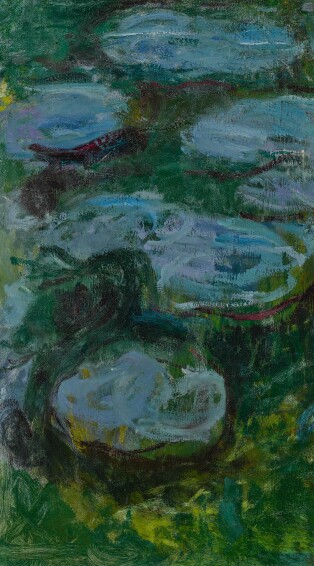- 436
CLAUDE MONET | Nymphéas (Fragment)
Estimate
600,000 - 800,000 USD
Log in to view results
bidding is closed
Description
- Claude Monet
- Nymphéas (Fragment)
- Oil on canvas
- 40 3/4 by 23 in.
- 103.4 by 58.4 cm
Provenance
Estate of the artist
Michel Monet, Paris (the artist's son; acquired from the above)
Galerie Granoff, Paris
Private Collection, Japan (acquired in the 1980s)
Private Collection, Asia
Acquired from the above by the present owner
Michel Monet, Paris (the artist's son; acquired from the above)
Galerie Granoff, Paris
Private Collection, Japan (acquired in the 1980s)
Private Collection, Asia
Acquired from the above by the present owner
Literature
Daniel Wildenstein, Claude Monet, Catalogue raisonné, Supplément aux peintures, dessins, pastels, vol. V, Lausanne, 1991, illustrated p. 180
Condition
The canvas is lined. The surface has a shiny varnish. There is some minor pigment shrinkage in the dark green and dark purple pigments and some fine lines of craquelure scattered throughout. Under UV light, there are small areas and lines of retouching in places throughout. Some of the sweeping brushstrokes in the lower left corner fluoresce. The work is on overall good condition.
In response to your inquiry, we are pleased to provide you with a general report of the condition of the property described above. Since we are not professional conservators or restorers, we urge you to consult with a restorer or conservator of your choice who will be better able to provide a detailed, professional report. Prospective buyers should inspect each lot to satisfy themselves as to condition and must understand that any statement made by Sotheby's is merely a subjective qualified opinion.
NOTWITHSTANDING THIS REPORT OR ANY DISCUSSIONS CONCERNING CONDITION OF A LOT, ALL LOTS ARE OFFERED AND SOLD "AS IS" IN ACCORDANCE WITH THE CONDITIONS OF SALE PRINTED IN THE CATALOGUE.
In response to your inquiry, we are pleased to provide you with a general report of the condition of the property described above. Since we are not professional conservators or restorers, we urge you to consult with a restorer or conservator of your choice who will be better able to provide a detailed, professional report. Prospective buyers should inspect each lot to satisfy themselves as to condition and must understand that any statement made by Sotheby's is merely a subjective qualified opinion.
NOTWITHSTANDING THIS REPORT OR ANY DISCUSSIONS CONCERNING CONDITION OF A LOT, ALL LOTS ARE OFFERED AND SOLD "AS IS" IN ACCORDANCE WITH THE CONDITIONS OF SALE PRINTED IN THE CATALOGUE.
Catalogue Note
Claude Monet’s Nymphéas are among the most iconic and celebrated Impressionist motifs and their profound impact on the evolution of Modern art marks them as Monet’s greatest achievement. The artist’s famous lily pond in his garden at Giverny provided the subject matter for most of his major later works, paintings whose significance in forging the path for subsequent artists is now fully recognized. The theme of waterlilies, that became Monet’s most celebrated series of paintings, recorded the changes in his style and his constant pictorial innovations. By 1890, Monet was able to buy the house and a large garden at Giverny which he had rented since 1883. With enormous vigor and determination, he swiftly set about transforming the gardens and creating a large pond for waterlilies. Upon their maturation, these waterlilies offered a wealth of inspiration that Monet went on to explore for the rest of his life (see fig. 1).
His carefully designed garden served as a microcosm in which he could observe and paint the changes in weather, season and time of day, as well as the ever-changing colors and patterns (see fig. 2). John House wrote: "The water garden in a sense bypassed Monet’s long searches of earlier years for a suitable subject to paint. Designed and constantly supervised by the artist himself, and tended by several gardeners, it offered him a motif that was at the same time natural and at his own command—nature re-designed by a temperament. Once again Monet stressed that his real subject when he painted was the light and weather" (John House, Monet, Nature into Art, New Haven, 1986, p. 31).
The present Nymphéas fragment is recorded in the fifth volume of Daniel Wildenstein's catalogue raisonné as a document of Monet's process.
His carefully designed garden served as a microcosm in which he could observe and paint the changes in weather, season and time of day, as well as the ever-changing colors and patterns (see fig. 2). John House wrote: "The water garden in a sense bypassed Monet’s long searches of earlier years for a suitable subject to paint. Designed and constantly supervised by the artist himself, and tended by several gardeners, it offered him a motif that was at the same time natural and at his own command—nature re-designed by a temperament. Once again Monet stressed that his real subject when he painted was the light and weather" (John House, Monet, Nature into Art, New Haven, 1986, p. 31).
The present Nymphéas fragment is recorded in the fifth volume of Daniel Wildenstein's catalogue raisonné as a document of Monet's process.

